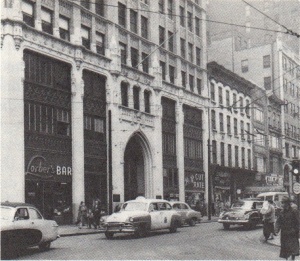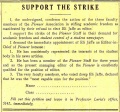Brooklyn CollegeFrom The Peopling of New York CityIt was clear that Brooklyn needed a borough college. Over one third of City College‘s full-time students were from Brooklyn, and aside from overcrowding, travel time took nearly four hours a day for many of them. The Board of Higher Education authorized Brooklyn College on April 22, 1930. It was a city college, thus with free tuition, and was situated in four (later five) buildings in downtown Brooklyn. The College was coeducational, sharing all-male City College’s curriculum and degree requirements for men and all-female Hunter College’s curriculum and degree requirements for women. In fall of 1931, classes were segregated until junior year, when financial constraints forced electives to be open to both men and women. Plans were made to, in time, segregate those as well. How could a college with free tuition limit the number of students flooding in? No applications with detailed background information were required by the college. Instead, students were accepted if they had adequate high school grades, and received a penny postcard notice of admission. The merger of City-Hunter College that had been established in Brooklyn in 1926 boasted 623 men and 308 women. On the first day of class at Brooklyn College, Thursday, September 18, 1930, these number tripled and quadrupled. 2,676 daytime students and 2,583 nighttime ones seemed to guarantee that “there is little doubt of the immediate and complete success of the local institution.” [1]
LocationsClasses were held in five temporarily rented areas of office buildings.80 Willoughby Street at the corner of Bridge Street 383 Pearl Street at Willoughby Street Ascutney Building at Willoughby and Lawrence Streets Chamber of Commerce building at 66 Court Street Six months later, they expanded to 165 Joralemon Street
Traveling between classes was often a pain. Fifteen minutes were allotted between each class because the five or six block distance between buildings and downtown Brooklyn traffic slowed almost everyone down. One student remembers: "I always received very low grades in phys ed because I would get on the floor late...But it was almost impossible with that crazy city traffic, to go from Willoughby Street to Joralemon Street, get undressed, put your things away in a locker, get dressed into your gym suit, and get on the floor on time...And, of course, the noise of that area...in the late spring and early autumn- it was frequently impossible to hear what was going on because of the din that existed in the streets. But still it made no difference - one never objected or talked about it as a disadvantage - we accepted it." [2] There was no space for teachers' offices or club rooms. Instead, students and faculty had to make do with what they had. Faculty members would meet with students in the rooms assigned to them, and time was set aside every Wednesday for clubs to meet in the classrooms. [3] Without sports facilities, the only athletic clubs were the gymnasts and the wrestlers, and there was a greater emphasis on literary clubs. [4] The theater department was also very active. Its beginnings were humble, a small platform in one of the classrooms, but as the theater troupe grew, local theaters were rented out for entertainment. [5] The Star Burlesque Theater, located behind the Lawrence Street building, was an unforgettable part of early Brooklyn College. Between shows, performers caught the attention of students sitting in the favored window seats in trigonometry class. Some students would even arrive early, "the better to learn about angles and curves." [6] Others skipped classes to go see performances there and in the other theaters and cinemas that surrounded them in downtown Brooklyn. Leon Labes recalls skipping a Shakespeare class "because there was a certain stripper that I was very anxious to see at the Star Burlesque and I told [the Professor] I wasn't quite sure whether I had gone from the sublime to the ridiculous or from the ridiculous to the sublime." [7] School LifeIn the era following the Great Depression, when "people were selling apples on the street" [8], students and faculty alike had to pinch pennies to manage. Despite its free tuition, school still cost money. Carfare to and from school for one student was five cents each way, or fifty cents a week.[9] Lunch had to be brought from home for most, because the average lunch in college was 15 cents, according to the Curator's Report. [10] The average stendent's college-related expenses were about $6.60 a week in 1934. The faculty also felt the toll of the economic situation. In 1930, the faculty had to "volunteer" one percent of their wages to the unemployment fund. Two years later, an emergency pay cut was levied on all city employees, and tiny salaries grew even smaller. Many cheap restaurants in the area were patronized by students and faculty alike during the day. [11] School NewspapersIn its first few years, three newspapers kept students informed. The first, the Brooklyn College Pioneer, by men and aimed at men; and the second, the Brooklyn College Spotlight, the female version; merged in 1935 to become the Brooklyn College Vanguard, with editors-in-chief formerly from both papers. The first editorial on February 28, 1936 carried the headline “We Take Our Stand” and stated: “We are not discarding the liberal traditions of either of the former newspapers—traditions based on faithfulness, dependability and honesty…We shall be faithful to the student body by publishing a newspaper which is representative of their interests…We shall necessarily ally ourselves with those youth organizations which are progressive in their principles, for Brooklyn College students have shown that they realize the necessity of working for the establishment of peace, the maintenance of academic and civil freedom and adequate educational facilities for all….We shall be honest in facing present conditions, honest and analyzing their solutions…If we succeed in making ourselves felt as a vital force in the College, not only in reporting activities, but in directing and guiding them, we feel that we shall successfully perform our function as the Brooklyn College newspaper.” [12] Controversy arose in 1935 when Eli Jaffe, a political radical, was rejected from the job of editor-in-chief of the Pioneer because of his political views, the votes of two student members of the Pioneer Association overridden by three faculty members. The newspaper staff went on strike, demanding that he be instated in the position. The Spotlight was quick to back up their decision, and [13] This was just one example of the many anti-authority statements Brooklyn College students became known for in the 1930's.Articles from the Pioneer Board, a two-page issue devoted to publicizing the strike: Alma MaterWhen a competition was announced to determine the alma mater for Brooklyn College, poet Robert Friend wrote a scathing parody of the genre that, to his chagrin, won the contest. [14] Sylvia Fine Kaye, then a student at Brooklyn College, wrote her own song, but the head of the music department, with whom she didn't quite get along, rejected her words in favor of Friend's and kept the music [15]. Media:BCAM.mp3 No one was pleased with this arrangement. Without her lyrics, Kaye greatly disliked the alma mater, and even a later Brooklyn College president, Dr. Robert Hess, found the song to be "truly unsingable" and pretentious. Hess eventually tracked Friend down at a college reunion. Friend's reaction was "I don't even want to think of it. I'm embarrassed by it. I'm sorry I wrote it." He told Hess to have Kaye rewrite the alma mater into the one we use today. [16] FacultyPresident William A. BoylanConflictCommunismAnti-war ProtestsNotes
|








